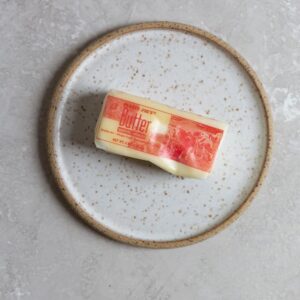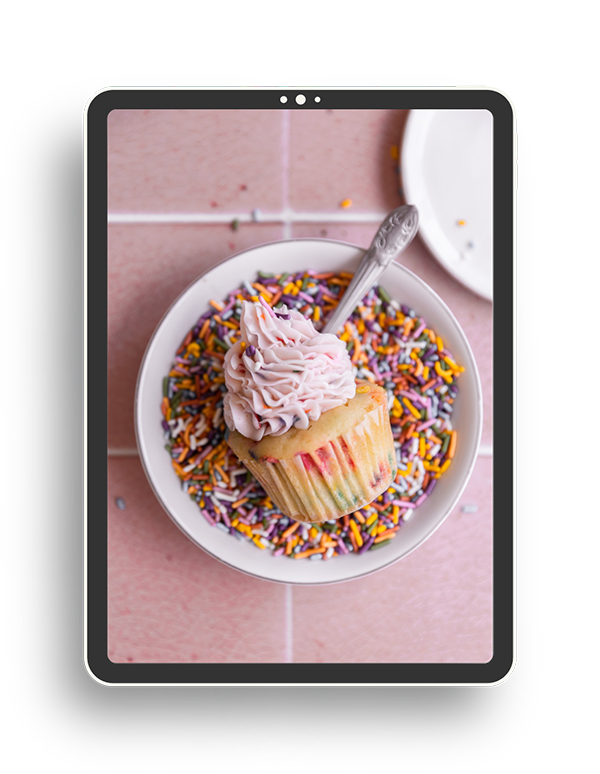How to soften butter quickly without melting
Use these tips below to learn how to soften butter quickly! You can use either a glass or a microwave without melting the butter. If you have ever forgotten to leave your ingredients out at room temperature before baking, then this post is for you! You’ll be baking in no time.

I am sure you have heard this before but baking is science.
Your recipes can change dramatically if you use the same ingredient in different ways. If you try making the same homemade cookie recipe with softened butter and then again with melted butter, you would have two different cookies.
Which is why it is so important to read and follow the recipe exactly when you are baking.
Butter is a key ingredient in many baking recipes and will 100% act differently if you use it cold, soft, what you think is soft (I’ll get to that in a minute), and melted.
As a trained pastry chef and baking blogger, I never have less that 2 lbs of butter in my fridge at all times LOL, but sometimes I forget to bring it to room temperature so I rely on the hacks below to soften it quickly!
What is softened butter?
Softened butter means butter that is brought to room temperature. It is the best way to use butter when recipes call for creaming butter and sugar together. The picture below is what softened butter is supposed to look like. It has a small indentation when pressed.

Why does butter have to be soft?
Let’s start here first.
Butter is a solid fat, and when softened is used to cream sugar. During the creaming process the butter is able to trap air. When baking, that air will expand from the heat of your oven which will create a super fluffy baked good.
The butter is also used to coat flour evenly which helps to distribute even amounts of fat throughout the batter, also creating a light treat.
Cold butter does not cream well and you will be left with a lumpy uneven batter.
The only time I use cold butter is for making streusel topping when the cold butter is needed for lumps.
And no, you cant just keep the mixer on longer, you need to start with room temperature butter to ensure a beautiful baked good.
Room temperature butter
Butter is at room temperature at around 68-70 degrees F. That is a little bit colder than you might realize.
You can tell that butter is softened correctly when you press it and it makes a small indentation. That does not mean that your whole finger slides right through it.
You can definitely over soften your butter which will again change the way your recipe is baked. I like to take my butter out 1-2 hours before I am baking, depending on how cold it is in my kitchen. That always ensures perfectly soft butter.
Check out the picture below to see what butter looks like at different temperatures.

The butter on the left is cold and was just taken out of the fridge. The one in the middle is our correctly softened butter. The butter on the right is overly softened-you don’t want that either.
Overly softened butter is when you poke the butter and your finger can basically go through the whole stick. If it is overly softened, you will have to stick it back in the fridge to cool it down.
Now that you know why soft butter is so important, let’s move on to the butter softening hacks!
3 ways to soften butter quickly
- Using a glass
- Microwaving a whole butter stick in short bursts
- Using residual heat from a microwave
How to soften butter with a glass
To soften butter with a glass, fill a microwave safe cup or a 2 cup Pyrex measuring cup with water and microwave it for 5 minutes. Spill out the water when it’s done. Stand the butter up (still in it’s wrapper) and place the glass over the stick of butter and leave for 5-10 minutes.
Lift the cup and the butter is soft, voila!




How to soften butter in the microwave
Some people say this is impossible, I say just be careful and know thy microwave! It’s easy to melt the butter by accident.
I have also seen people say use 50% power and honestly I have NO IDEA what that means, but I have figured out a way to do it that actually works.
Place one unwrapped stick of butter on a microwave safe plate and microwave for 5 seconds. Take the butter and physically rotate the stick so it sits on another side. Microwave for 5 more seconds. Repeat with another side. Make sure to watch the video so you can see exactly what I mean.

I usually only have to repeat this for 15 seconds total (3 sides) before its soft. Make sure it’s not on the verge of melting because then you need to start again.
How to use residual heat to soften butter
This is a trick that combines the first two ways.
Unwrap the butter and cut it into 8 tablespoons.
Next, fill a microwave safe glass full of water about 1 1/2 – 2 cups full. Microwave for 5 minutes. Then quickly remove the water from the microwave and place the plate of butter inside for 10 minutes.
The residual heat from the microwave is strong enough to soften butter even when it’s off. You don’t have to turn the microwave on again.
How to soften butter without a microwave
- Boil water on the stove.
- Pour the water into a 2 cup glass that is safe to hold hot water. Let it sit for 3 minutes.
- Spill the water out and invert the glass over a stick of butter with its wrapper still on.
- Wait 10 minutes and the butter will be soft!
More Expert Baking Tips
- All your refrigerated ingredients should be at room temperature before baking, unless the recipe specifically calls for something to be cold. This really ensures a smooth mixture and best results!
- To bring eggs to room temperature, fill a glass with warm water and let the eggs sit in the water for 5 minutes.
- Always measure your flour correctly. The most accurate way to measure flour is with a kitchen scale. If you dont want to get one then the best way to measure is by fluffing up your flour, then spoon it into a measuring cup and level off with the back of the knife. Never scoop flour directly with your measuring cup as you will end up using to much flour and your recipe will flop!
- I always bake on light colored aluminum sheet trays as they offer the best heat distribution. Darker sheet pans bake faster and can over bake your goodies.
- A 3 tbsp cookie scoop is the best for scooping cookies AND for filling cupcakes, as they are the perfect size!
Recipe FAQ
YES! Melted butter is different then softened butter and will alter your recipe in different ways. For example in cookies it will make the cookies thinner and crispier. In cake it will make the cake very dense because it wont be able to create the air bubbles that softened butter creates to lift the cake.
Yes of course! It will just harden up again once chilled. It is safe to use.
A lot of recipes call for unsalted butter so that you can control the amount of salt yourself in the recipe.
Recipes using softened butter
- Coffee Cookies with Chocolate Chunks
- Chantilly Cake
- Red velvet bundt cake
- Classic American Buttercream
- Caramel Buttercream Frosting
Recipes using melted butter

How to soften butter quickly without melting
Ingredients
- 2 cups water
- 1 stick butter
Instructions
How to soften butter with a glass.
- Fill a microwavable safe glass with 2 cups of water and microwave for 5 minutes or until boiling.
- Pour the water out and invert the glass over a stick of butter still in its wrapper.
- Wait 10 minutes, lift the glass and the butter will be soft
How to soften butter in the microwave
- Place one unwrapped stick of butter on a microwavable safe plate. Microwave for 5 seconds, then rotate the butter so it's sitting on another side.
- Repeat one more time until softened.
How to use residual heat to soften butter
- Cut up butter into 8 tablespoons and place on a plate.
- Fill a microwavable safe glass with 2 cups of water and microwave for 5 minutes or until boiling.
- Quickly remove the glass and replace it with the plate of butter. Close the microwave and leave it inside for 10 minutes. The residual heat will soften the butter quickly.

